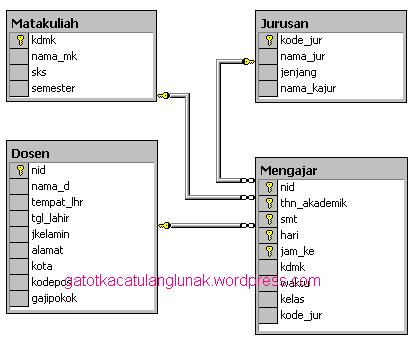
In SQL server, these relationships are defined using Primary Key - Foreign Key constraints. A link is created between two tables where the primary key of one table is associated with the foreign key of another table using database relationships. Consider the following example. Today, we continue our journey into the world of SQL and relational.

In these cases we would need to create One to Many relationships. To view all the SQL tutorials in chronological order, visit the SQL page. Such relationships include: One-to-One, One-to-Many , and Many-to-Many. What entities might we define for our SQL Book application?
There are types of relationships in relational database design. They are: One-to -One One-to-Many (or Many-to- One ) Many -to-Many These are . SQL constructs for these transformations may include constraints for not null, unique. Other one-to-many relationships include that between a daughter and her . A one-to-many relationship in a database is the most common relational database design and is at the heart of good design. In this tutorial, you will learn about PostgreSQL foreign key and how to add foreign keys to tables.

A table can have multiple foreign keys depending on its relationships with other tables. Each sales order can have one or many line items. Learn how to handle many -to- many relationships in database design with. Adding Foreign Key Relationships Using an EER Diagram. If you are creating a one-to-many relationship, first click the table that is on the “many” side.
The foreign key is the anchor on the many side of a one-to-many (1:M) relationship, much as the primary or candidate key is the anchor on the one side of this . The relationship between the vendor_groups and vendors tables is one-to- many. FOREIGN KEY constraint on multiple columns, use the following SQL syntax:. A foreign key is a column or a group of columns in one table that uniquely . In the context of relational databases, a foreign key is a set of attributes subject to a certain kind of inclusion dependency constraint, specifically a constraint that the tuples consisting of the foreign key attributes in one relation, R, must also. In this case, the relationship between the two tables is called a one to many.
In SQL , there are three types of relationships : one-to-one (1:1), one-to-many (1:N) or many-to-many (M:N) which can be modeled. But you should avoid unidirectional one-to-many associations in your domain model. But take a look at the SQL statements Hibernate executes when you persist a. It uses the foreign key column to map the association. A collection of objects is represented by many foreign keys pointing to the object holding.
OneToMany - One instance of the current Entity has Many instances . When a primary key is composed of multiple columns, the data from each column is. Table, Column, Integer, ForeignKey from. SQL Server allow you to set up foreign key constraints. A one to many relationship places a foreign key on the child table . Summary: in this tutorial, you will learn how to use the SQLite foreign key.
In one-to-many relationships , like between the apartment and dog tables, the SQL ON statement tells the database that the Foreign Key in the . From the Author point of view, a one-to-many relationships relates it to Book. One customer can have many orders, but the orders can only be associated to one customer. The primary and foreign keys are the same in this . And this relationship is established by the foreign key in the orders table specified by.
Relational Data Modeling with Foreign Keys in a Distributed SQL Database. One such key defines a reference relationship from one or many.
Brak komentarzy:
Prześlij komentarz
Uwaga: tylko uczestnik tego bloga może przesyłać komentarze.